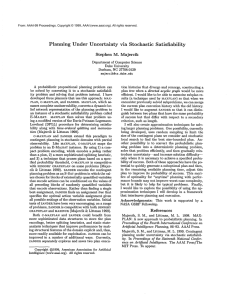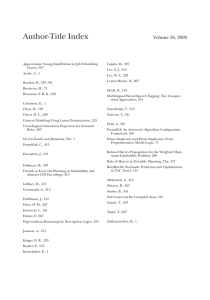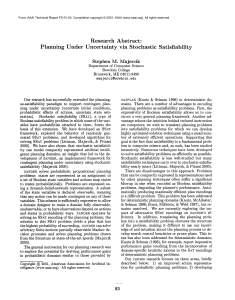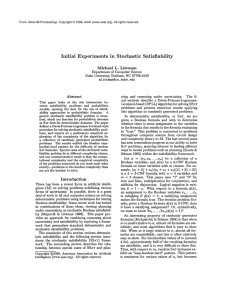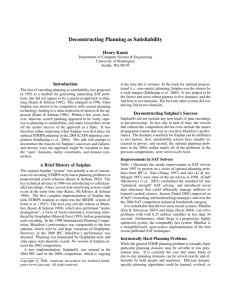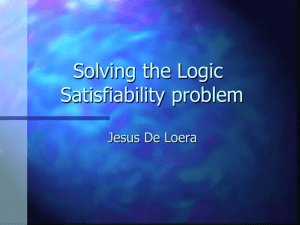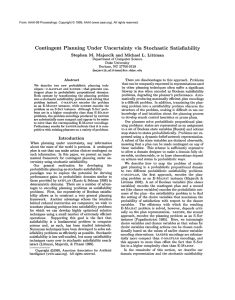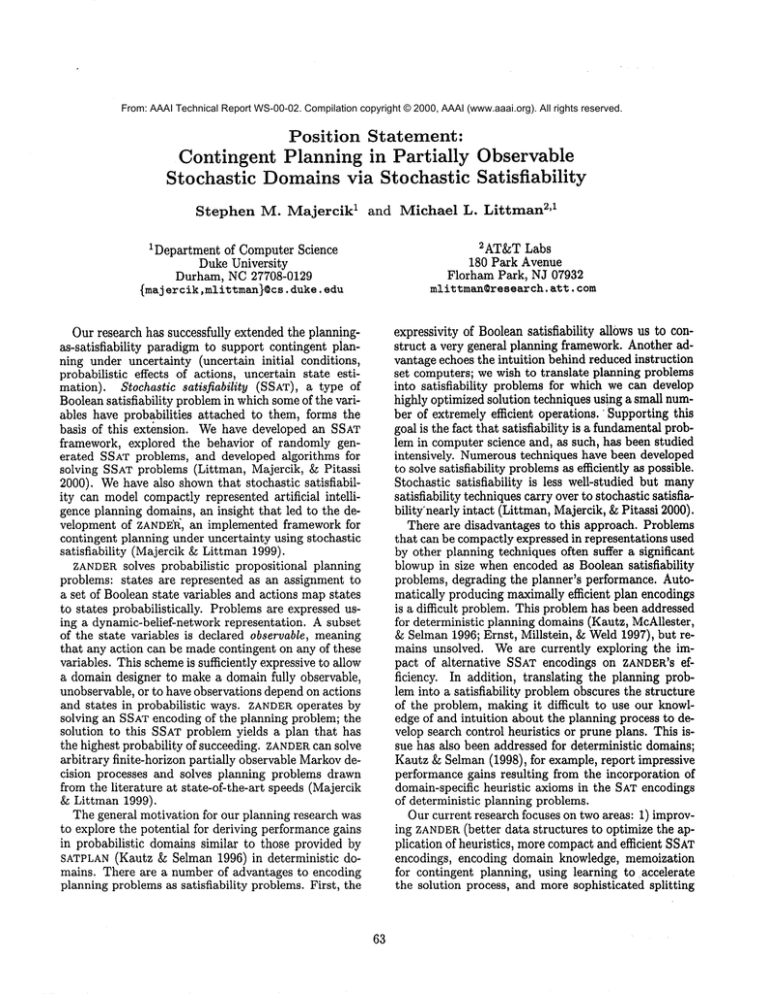
From: AAAI Technical Report WS-00-02. Compilation copyright © 2000, AAAI (www.aaai.org). All rights reserved.
Position Statement:
Contingent Planning in Partially Observable
Stochastic Domains via Stochastic Satisfiability
Stephen
M. Majercik
1 2’1
and
1Department of Computer Science
Duke University
Durham, NC 27708-0129
{majercik,mlittman}©cs,
duke.edu
Michael
L.
Littman
2AT&T Labs
180 Park Avenue
Florham Park, NJ 07932
mlittman@research,
art. com
expressivity of Boolean satisfiability
allows us to construct a very general planning framework. Another advantage echoes the intuition behind reduced instruction
set computers; we wish to translate planning problems
into satisfiability
problems for which we can develop
highly optimized solution techniques using a small number of extremely efficient operations. ’Supporting this
goal is the fact that satisfiability is a fundamentalproblem in computer science and, as such, has been studied
intensively. Numeroustechniques have been developed
to solve satisfiability problemsas efficiently as possible.
Stochastic satisfiability
is less well-studied but many
satisfiability techniques carry over to stochastic satisfia~
bility’nearly intact (Littman, Majercik, & Pitassi 2000).
There are disadvantages to this approach. Problems
that can be compactly expressed in representations used
by other planning techniques often suffer a significant
blowup in size when encoded as Boolean satisfiability
problems, degrading the planner’s performance. Automatically producing maximally efficient plan encodings
is a difficult problem. This problem has been addressed
for deterministic planning domains (Kautz, McAllester,
& Selman 1996; Ernst, Millstein, & Weld 1997), but remains unsolved. Weare currently exploring the impact of alternative SSAT encodings on ZANDER’S efficiency. In addition, translating the planning problem into a satisfiability problem obscures the structure
of the problem, making it difficult to use our knowledge of and intuition about the planning process to develop search control heuristics or prune plans. This issue has also been addressed for deterministic domains;
Kautz & Selman (1998), for example, report impressive
performance gains resulting from the incorporation of
domain-specific heuristic axioms in the SATencodings
of deterministic planning problems.
Our current research focuses on two areas: 1) improving ZANDER
(better data structures to optimize the application of heuristics, more compactand efficient SSAT
encodings, encoding domain knowledge, memoization
for contingent planning, using learning to accelerate
the solution process, and more sophisticated splitting
Our research has successfully extended the plann!ngas-satisfiability
paradigm to support contingent planning under uncertainty (uncertain initial conditions,
probabilistic effects of actions, uncertain state estimation). Stochastic satisfiability
(SSAT), ty pe of
Booleansatisfiability problem in which someof the variables have probabilities
attached to them, forms the
basis of this extension. Wehave developed an SSAT
framework, explored the behavior of randomly generated SSATproblems, and developed algorithms for
solving SSATproblems (Littman, Majercik, & Pitassi
2000). Wehave also shownthat stochastic satisfiability can model compactly represented artificial intelligence planning domains, an insight that led to the development of ZANDE’I~, an implemented framework for
contingent planning under uncertainty using stochastic
satisfiability
(Majercik & Littman 1999).
ZANDERsolves probabilistic
propositional planning
problems: states are represented as an assignment to
a set of Boolean state variables and actions map states
to states probabilistically.
Problems are expressed using a dynamic-belief-network representation. A subset
of the state variables is declared observable, meaning
that any action can be made contingent on any of these
variables. This schemeis sufficiently expressive to allow
a domain designer to make a domain fully observable,
unobservable, or to have observations depend on actions
and states in probabilistic ways. ZANDER
operates by
solving an SSATencoding of the planning problem; the
solution to this SSATproblem yields a plan that has
the highest probability of succeeding. ZANDEI~ can solve
arbitrary finite-horizon partially observable Markovdecision processes and solves planning problems drawn
from the literature at state-of-the-art speeds (Majercik
& Littman 1999).
The general motivation for our planning research was
to explore the potential for deriving performance gains
in probabilistic domains similar to those provided by
SATPLAN
(Kautz & Selman 1996) in deterministic
domains. There are a number of advantages to encoding
planning problems as satisfiability
problems. First, the
63
heuristics), and 2) developing an approximation technique for solving SSAw-encodedplanning problems that
will allow us to scale up to larger domains.
Acknowledgments: The first
author acknowledges
the support of a NASAGSRPFellowship.
References
Ernst, M. D.; Millstein, T. D.; and Weld, D. S. 1997.
Automatic SAT-compilation of planning problems. In
Proceedings of the Fifteenth International Joint Conference on Artificial Intelligence, 1169-1176.
Kautz, H., and Selman, B. 1996. Pushing the envelope:
Planning, propositional logic, and stochastic search. In
Proceedings of the Thirteenth National Conference on
Artificial
Intelligence,
1194-1201. AAAIPress/The
MIT Press.
Kautz, H., and Selman, B. 1998. The role of domainspecific knowledge in the planning as satisfiability
framework. In Proceedings of the Fourth International
Conference on Artificial Intelligence Planning, 181189. AAAIPress.
Kautz, H.; McAllester, D.; and Selman, B. 1996. Encoding plans in propositional logic. In Proceedings
of the Fifth International Conference on Principles
of Knowledge Representation and Reasoning (KR-96),
374-384.
Littman, M. L.; Majercik, S. M.; and Pitassi, T. 2000.
Stochastic Boolean satisfiability.
Journal of Automated Reasoning. In press.
Majercik, S. M., and Littman, M. L. 1999. Contingent planning under uncertainty via stochastic satisfiability. In Proceedings of the Sixteenth National Conference on Artificial Intelligence, 549-556. The AAAI
Press/The MIT. Press.
64

